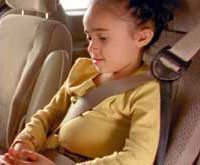Booster Seats Can Save Your Child's Life in an Accident
Just
40 percent of children aged 4 to 8 use car safety seats
or booster seats at least occasionally -- meaning that most
children risk being thrown from the car in the case of an
accident, according to a study released on Tuesday.
The
study, published in the Annals of Emergency Medicine, shows
that many people driving children do not have booster seats,
and feel the risk is acceptable because they are making
only short trips.
 |
|
"Emergency
physicians cringe when we see a child riding unrestrained
in a vehicle because we know if it crashes, the child
will be hurled like a missile," said Dr. Herbert
Garrison. |
"Emergency
physicians cringe when we see a child riding unrestrained
in a vehicle because we know if it crashes, the
child will be hurled like a missile," Dr.
Herbert Garrison of East Carolina University in
Greenville, N.C., wrote in a commentary on the
survey. "The result for the child may be
severe injury or death."
For
the survey, the National Highway Traffic Safety Administration
interviewed 6,000 randomly chosen Americans over the age
of 16 in 2003, asking questions about safety belts, child
safety seats, airbag crash injuries and other issues.
The
survey found that 21 percent of children aged 4 to 8 rode
in a booster seat even occasionally, while another 19 percent
rode in a front-facing child safety seat at least on occasion.
State
laws vary on when and how children should be in safety seats
but children up to about 40 pounds should ride in child
safety seats.
After
that, experts recommend booster seats to make sure smaller
children fit properly into safety belts.
Half
the parents and care givers who put the child into a booster
seat only occasionally said the child was only in the vehicle
a very short time. Another 41 percent said no seat was available
and 34 percent said the child did not like the seat, the
NHTSA survey found.
Motor
vehicle crashes are the most common cause of childhood
death in the United States.
"Children ages 4 to 7 who ride in booster seats are 59 percent less likely to be injured in a crash than children restrained by only a safety belt," Garrison wrote.
Those who provide medical care for children cringe when we see a child riding unrestrained in a vehicle. We know that should the vehicle crash, the child will be hurled like a missile that bursts when it lands. The result for the child may be severe injury or death that is prevented so easily with the proper use of child safety restraints.
We do see unrestrained children in vehicles less frequently. Between 1994 and 2002, observed restraint of infants in vehicles increased from 88% to 99%. For the same time period, observed restraint of toddlers in vehicles increased from 61% to 94%.
Coinciding with the increase in restraint use for children has been a decrease in the childhood crash-related injury and death statistics that can often seem so grim. In 1994, 1,709 passenger vehicle occupants aged 0 to 14 years died in motor vehicle crashes. There has been a steady decline in the annual number of traffic fatalities among children since, reaching a low of 1,439 in 2002. Among infants and toddlers for the same time period, the annual traffic fatality rate decreased by more than 30%.
How we got to this point of significant improvement in child occupant safety is a tragic paradox. The paradox involves a safety device - the air bag - that was invented only to save lives and reduce injuries. Instead, early versions of the air bag killed and severely injured children who were out of position or not restrained when the air bag deployed. The cases and numbers of air bag deaths were shocking to the injury prevention community and the public. Eventually, we learned that it was a combination of the deploying air bag and an improperly restrained or unrestrained child that produced the worst injuries. For those children who were in the path of the air bag when it deployed, this paradox - death from air bag - was an unintended consequence of the worst kind.
The good news is that the air bag injuries in children led to a safety campaign aimed at getting children out of the way of the deploying air bag. Consumer education directed to parents now emphasizes that children should always ride in the vehicle's rear seat. This renewed emphasis on enhanced protection of the child occupant of a motor vehicle got more children into the safer back seat and more of them properly restrained. Consequently, air bag-related fatalities among children have all but disappeared.
The great story of child safety in vehicles remains unfinished. Motor vehicle crashes remain the most common cause of childhood death, and we still have many children improperly restrained. As reported in this month's NHTSA Notes, the National Highway Traffic Safety Administration (NHTSA) 2003 Motor Vehicle Occupant Safety Survey, which is a national sample, revealed that only 21% of children aged 4 to 8 years were restrained in a booster seat and another 19% were in child safety seats. In a separate study, Winston and Durbin found that 62% of children aged 4 to 8 years were inappropriately restrained in adult seat belts.
Moving a child out of a child safety seat and into a safety belt too early greatly increases risk of injury. Children aged 2 to 5 years who are prematurely graduated to safety belts are four times more likely to suffer a serious head injury in a crash than those who are in child safety seats or booster seats.
Booster seats are very effective in preventing injury. Children aged 4 to 7 years who ride in booster seats are 59% less likely to be injured in a crash than children restrained by only a safety belt. Children aged 4 to 8 years are old enough (and usually big enough) to graduate out of their child safety seats, but most of them still need to be in a booster seat. Booster seats elevate the child so that the vehicle's safety belts, which are designed for adults, fit children snugly at the shoulder and the pelvis instead of around the neck and abdomen, which is inappropriate and dangerous. In a crash, a belt that is tightening on the neck and abdomen can, paradoxically, cause severe injury. Booster seats that position the safety belt correctly reduce injuries usually associated with improper seat belt fit in children.
The Motor Vehicle Occupant Safety Survey and other studies show that there are many reasons why children aged 4 to 8 years are riding improperly restrained (ie, not in booster seats): parents lack knowledge about booster seats; parents think that booster seats are loose, unstable, or unsafe; parents think their children are large enough to avoid them; and pressure from their children and even other parents to quit treating their children like babies.
 |
It's ironic that booster seats are the easiest to use of all child safety seats but the ones used the least. |
It's ironic that booster seats are the easiest to use of all child safety seats but the ones used the least. How then can we increase their usage? The Motor Vehicle Occupant Safety Survey showed that the public favors strong enforcement of child restraint laws. Currently, 28 states have enacted some type of booster seat requirement, although the children's ages covered in the laws and enforcement of those laws vary greatly. In North Carolina, for example, a law that became effective on January 1, 2005, requires that children younger than 8 years and who weigh less than 80 pounds be restrained in a child safety seat. This will allow police to enforce the idea that a child older than 4 years should always be in a booster seat. The effect of the booster seat laws is still to be determined.
Community interventions designed to increase booster seat use show promise. Ebel et al, in a rare controlled evaluation, found that a multifaceted community education campaign significantly increased the use of child booster seats. The elements of the booster seat campaign included a promoting coalition, a citizen advisory group, broad-based community education, discount booster seat coupons, and car seat training programs.
What about kids aged 9 years and older? When does a child graduate from a booster seat? The simple answer is when the adult safety belt fits them correctly. This can be different for every make and model of vehicle. Parents will have to look to make sure that the shoulder portion of the belt is off the neck and on the child's shoulder where it belongs and that the lower portion of the belt is off the abdomen and on the hips.
Every time we see a child brought into the emergency department with crash injuries that could have been so easily prevented, we have an opportunity to intervene on the child's behalf and do the right thing. As emergency physicians, we need to use our influence to make sure parents know that all children should be in the vehicle's back seat and that children older than 4 years should be in the type of child restraint that fits them best, most likely a booster seat. This will help keep them from becoming a missile in a crash and make sure the safety belt does its intended job-to keep the child safe. |